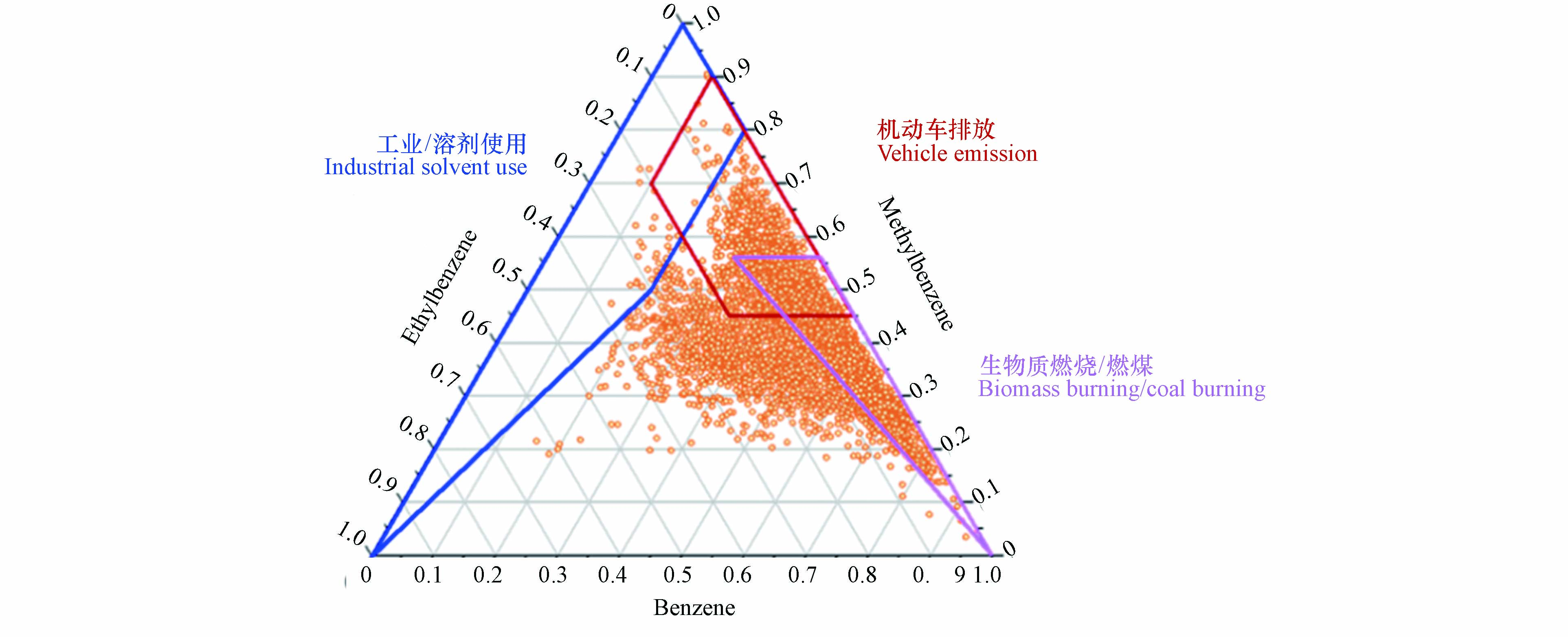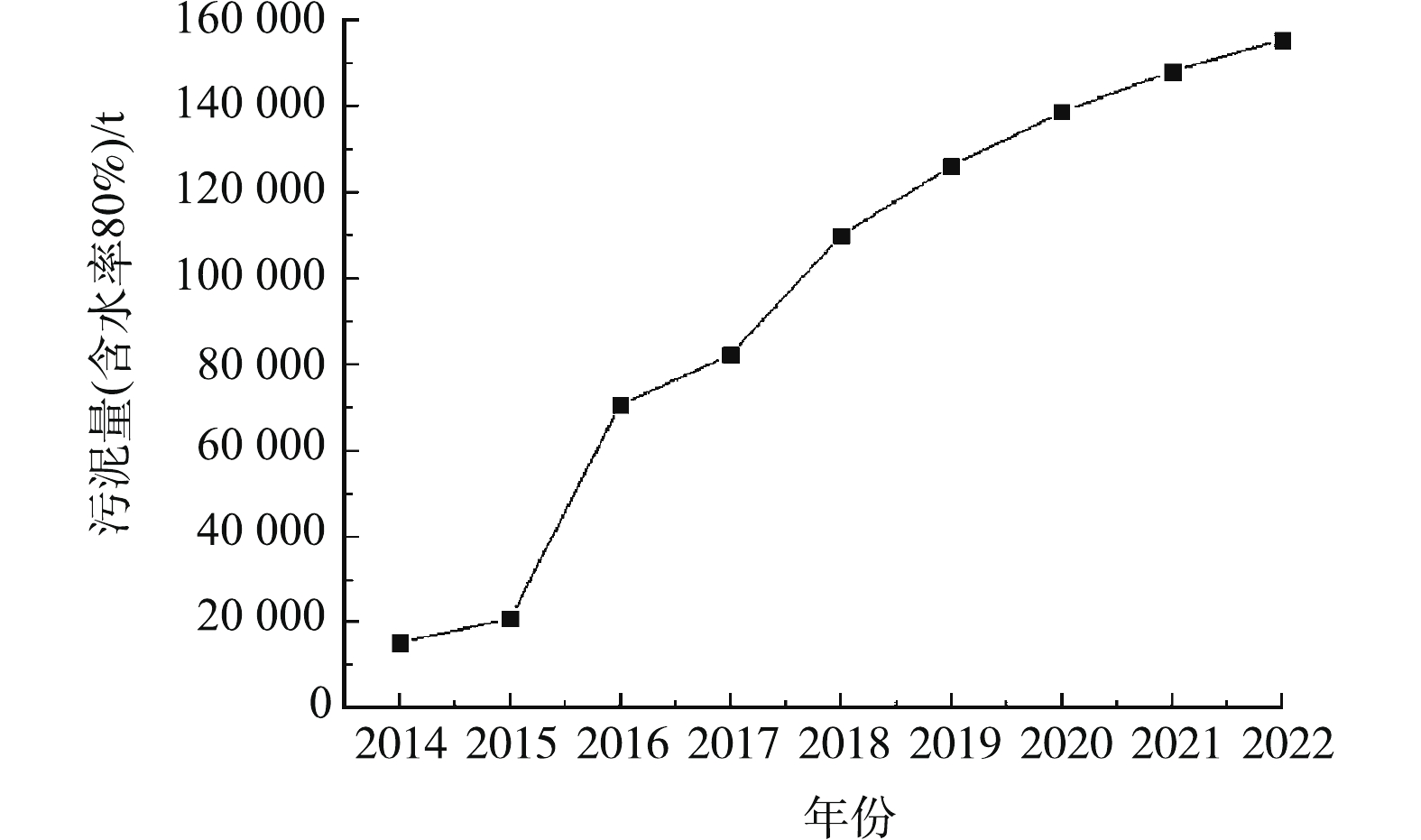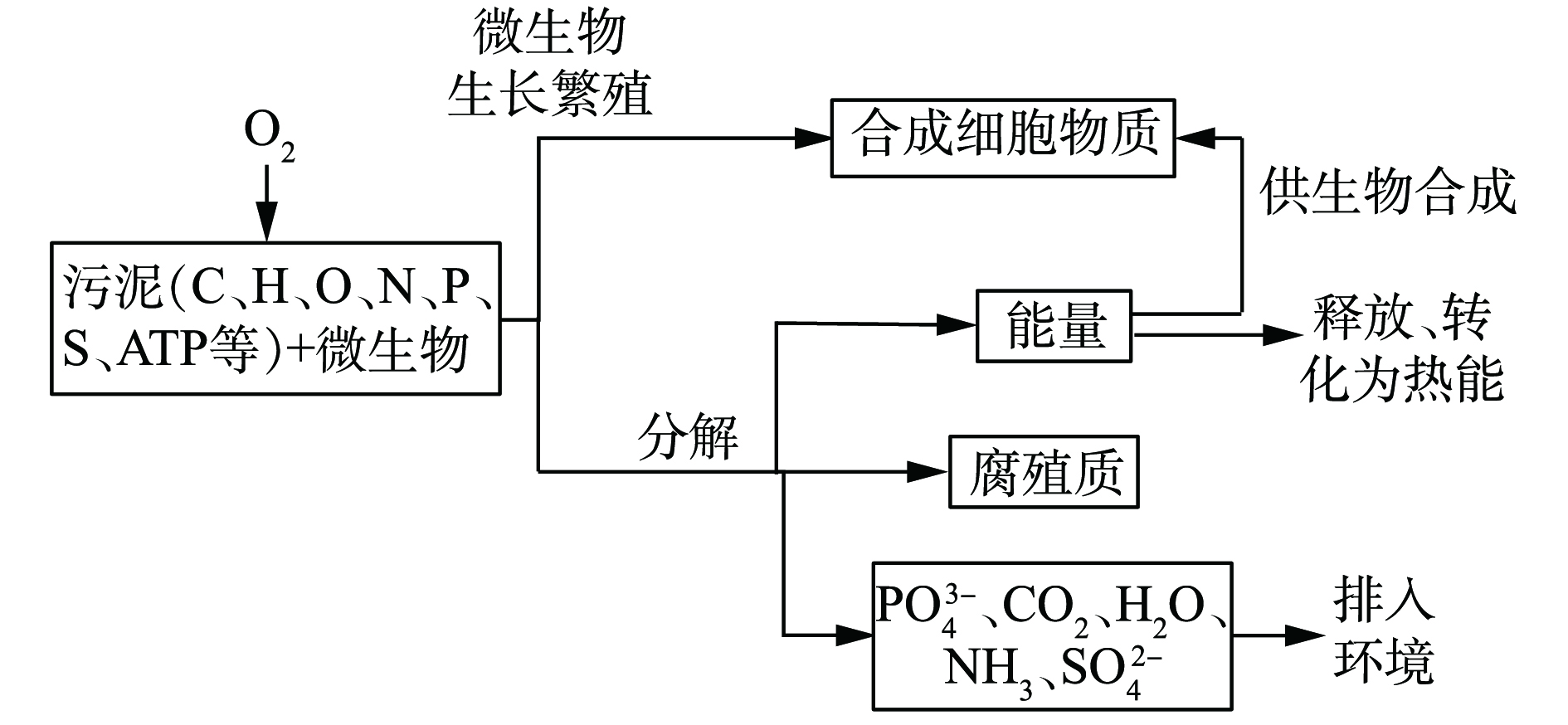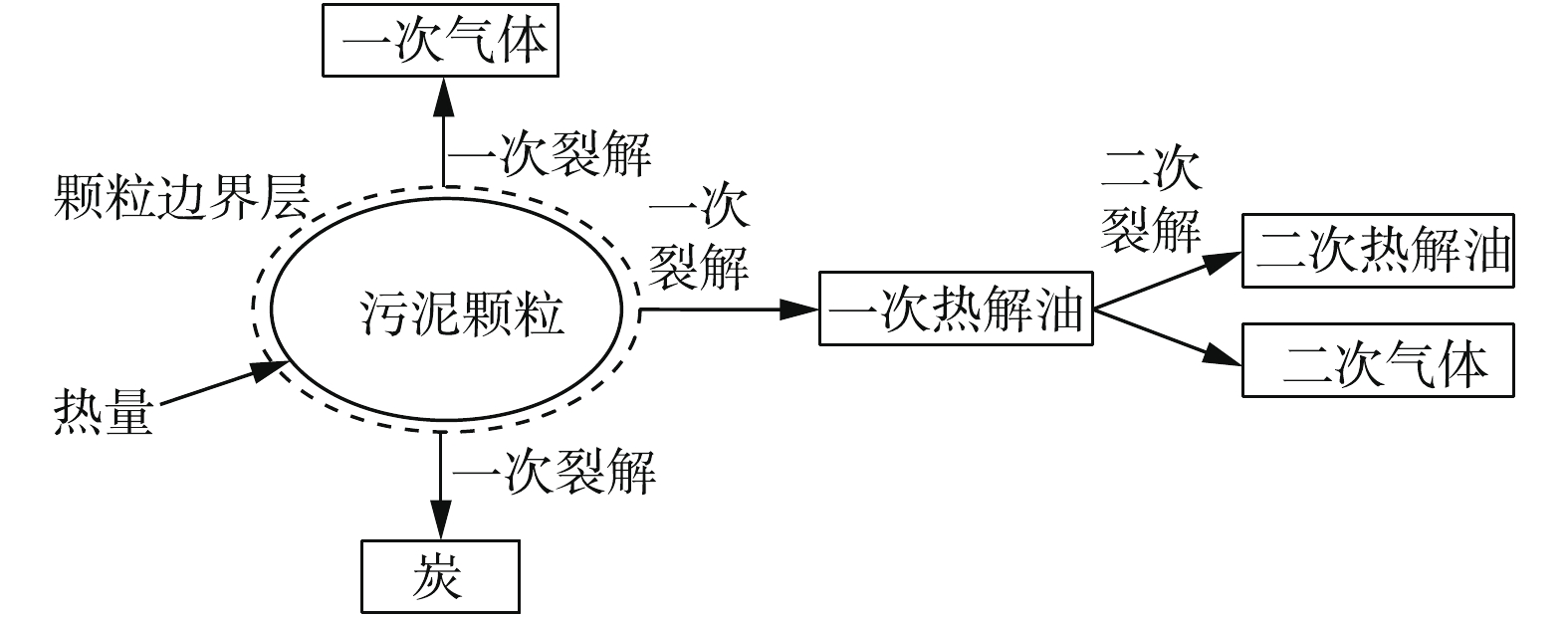-
近年来,随着我国西藏自治区(简称西藏)经济的快速发展与城镇化建设进程的推进,拉萨市、那曲市、日喀则市的多座污水厂投入运行,市政污泥产量也随之增加。2017年,西藏市政污水处理量达1.03×108 t[1],据此推算,污泥量约8.23×104 t[2](含水率80%)。这些污水处理厂由于缺乏后续配套的处理设施,大量污泥只能堆积在厂房中,严重影响了设备的正常运行。此外,对西藏污泥特性的未知,加深了污泥对环境危害的不确定性。若不能将数量庞大的污泥妥善处理,会对西藏脆弱的生态环境造成不可逆的影响[3]。
由于西藏自治区缺乏针对性研究和技术指导,目前尚未形成成熟的污泥处理方法。考虑到西藏的垃圾填埋场已趋于饱和,污泥干化后运至填埋场填埋并非长久之计。同时,污泥中含有大量的有机物和营养物质,污泥的处理方法可转向有机废物的资源化利用[4]。在平原地区,主要的资源化方式包括土地利用[5]、能源利用[6]、制备环保材料[7]等。几种资源化利用技术分别有一定的优势:好氧堆肥技术操作简单、周期短、效率高,有机物分解彻底,产物稳定[8];厌氧发酵技术受污泥含水率的影响较小,产生的甲烷可用于供电和供热[9];热解技术产生的生物炭可用于吸附重金属或有机污染物[10];污泥与垃圾混合焚烧技术可降低二恶英等污染气体的排放[11],将热能转化为电能,可节约化石燃料的费用;污泥衍生燃料具有较高的热值,燃烧效率高[12];厌氧发酵与气化耦合技术可通过微生物发酵产生沼气,沼渣中未完全降解的有机物通过气化技术转换为生物质燃气[13],实现全部有机物的资源化利用。
在西藏自治区,须考虑其气压低、氧含量低、昼夜温差大等特殊条件,不能直接照搬平原地区运行良好的资源化利用方法,处理工艺和运行方法都须做出调整。本研究从原料出发,通过取样分析,总结了西藏污泥的特性;根据已有数据,对西藏污泥产量进行了预测;结合西藏污泥的特性与产量,提出了符合西藏特点的处置方案,进而分析每种技术的资源化利用潜力;结合每项技术的经济效益、社会效益及西藏本地的需求,为污泥推荐最优的资源化利用方案。本研究为西藏自治区的污泥处置问题提供新思路,为找到适合西藏地区的污泥资源化利用方法提供了参考,具有理论意义与应用价值。
全文HTML
-
实验用污泥取自西藏自治区拉萨市某污水处理厂,为未经发酵处理的新鲜污泥。污泥取回后含水率为80%~85%,故采用自然晾晒法进行干燥后,再放入烘箱中,在105 ℃恒温下烘烤24 h。取出冷却后,粉碎、研磨并过100目筛,取筛下物备用。
污泥的热化学基础特性包括元素分析、工业分析、重金属含量分析及XRF分析。元素分析与工业分析分别使用《煤的元素分析》(GB/T 31391-2015)[14]、《固体生物质燃料工业分析方法》(GB/T 28731-2012)[15]中的方法进行测试。重金属含量测试使用HNO3-HClO4法消解,再利用ICP装置进行测试。XRF采用射线荧光光谱仪对污泥中Si、Fe、Al、P、K、Ca、Si、Mg、Ti、Na、Cl、Mn、Sr、Rb、Zr和Co元素的含量进行测试。
-
1)污泥量计算模型。通常,污水处理厂处理1×104 t生活污水可产生含水率80%的污泥5~8 t[2],此处选取8 t计算,由于同一污泥在不同含水率下干物质的质量不变,可计算出不同含水率下的污泥质量(如式(1)所示)。
式中:
α1 和α2 为污泥含水率;m1和m2分别为含水率为α1 和α2 时的污泥质量。 -
2)灰色预测模型。灰色预测模型适用于数据样本点个数少(最少4个)、数据呈现指数或曲线形式及做中短期的预测。由于西藏污泥量数据样本较少且呈现曲线形式,故采用灰色GM(1, 1)模型[16],基于MATLAB软件进行预测。
为了保证建模方法的可行性,须对无规律的西藏污泥量原始数据x(0)进行平移变换,使其变为光滑离散函数序列。建立西藏污泥产量的时间序列(如式(2)所示)。
由于式(2)为西藏污泥量的原始序列,其规律性不强,因此,在预测前,须对
x(0) 进行一次累加,如式(3)所示。在数据具有一定规律性后,可建立GM(1, 1)的白化微分方程,如式(4)所示。
式中:
a 为发展系数;b 为灰作用量。该方程的特解如式(5)所示。由式(2)~式(5)得出2014—2017年西藏污泥产量的模型预测值后,通过计算预测值与真实值之间的级比偏差、相对误差及平均相对误差的数值,来判断预测结果是否可靠。相对误差算法如式(6)所示,级比偏差算法如式(7)所示,平均相对误差算法如式(8)所示。
式中:
δ 为相对误差;s 为真实值;s′ 为预测值。式中:
ρ 为级比偏差;λ(k) 为真实值的级比;λ(k)′ 为预测值的级比。式中:
¯δ 为平均相对误差;δ1∼δ4 分别为4个样本的相对误差。若相对误差小于
α ,且平均相对误差也小于α ,则说明预测结果可靠,可以用该模型进行预测。此处,α 取0.5。 -
3)产品量计算模型。由污泥产量计算其资源化处理可得的产品量,如式(9)或(10)所示。
式中:
Pi 为某产品的产量,t或m3;mαx 为含水率αx 时的污泥质量,t;β 为产率系数,表示1 t污泥可产生的产品量,t·t−1或m3·t−1;γ 为产率,表示污泥中转化为某产品的质量占污泥总质量的百分比。
1.1. 实验材料与方法
1.2. 计算方法
-
元素分析是污泥的基础指标,可为热化学计算提供依据并预测热化学转化率。西藏污泥及代表性城市[17-21]的元素分析结果见表1。可以看出,西藏污泥的碳、氢元素含量相对较高,故有机质含量较高。氮元素含量达到6.46%,而一般煤炭的氮元素含量均在2%以下[22],这可能使污泥焚烧等利用过程中氮氧化物的排放浓度超标,因此,要注意采取适当的脱硝措施控制氮氧化物排放。相比之下,西藏污泥中硫元素含量较低(1%以下),因此,相较于其他5个城市,西藏污泥在焚烧等过程中硫氧化物排放浓度最低,但仍须注意监测是否超标。
-
西藏污泥及代表性城市[17-21]的工业分析结果见表2。可以看出,西藏污泥中挥发分含量最高,达到60%以上,这说明污泥中含有较多的有机质。其次是灰分,约占28%,由于灰分的存在,热干化利用后也会遗留部分残渣。固定炭和水分含量较低,对干化焚烧、热解等过程影响较小。
与其他5个城市相比,西藏污泥灰分含量最低,挥发分含量最高,同时水分含量也较低,说明西藏污泥有机物质丰富,无机物含量较低。对西藏污泥进行焚烧或热解气化处理时,挥发分是主要的有效成分;且西藏污泥灰分含量最低,产生的灰渣更少,对焚烧炉、热解气化炉等设备运行维护更有利。
-
市政污泥中的重金属主要来自工业废水、生活污水和雨水径流[17],主要包括As、Cr、Cd、Cu、Hg、Ni、Pb、Zn等[5]。西藏污泥的重金属含量如表3所示,8种元素含量从高到低依次为Zn>Cu>Cr>As>Pb>Ni>Cd>Hg。其中,Zn元素含量最高,达294.84 mg·kg−1;Cd元素和Hg元素处于较低水平,均低于2.5 mg·kg−1。除As外,西藏污泥中的重金属含量均低于《农用污泥污染物控制标准》(GB 4284-2018)[23]中的A级与B级极限值。因此,将西藏污泥无害化处理后用于牧草地施肥、土地修复等是符合国家标准的,造成二次污染的危险性较小,这使得西藏污泥资源化处理更具优势。
已有研究[24]表明,我国污泥中重金属含量排序为Zn>Cu>Cr>Pb>Ni>As>Cd>Hg,西藏污泥仅As一项含量较低,其余排序和全国规律一致。但由于不同地区、不同来源的污泥中,重金属含量差别较大,故选取7个城市[17-20, 25-27]作为对比,如表3所示。在西藏污泥中,除As和Pb元素外,其余6种重金属含量均远低于其他城市,这是由于西藏工业不发达,且终年降雨量少,污泥多来源于生活污水所致。西藏污泥中含量最高的锌元素仅为大连市的1/10,Cu元素含量仅为大连市的1/50,Cr元素为天津市的1/17,较为清洁。此外,西藏自治区污水处理厂投产时间较短,运行工艺及设备的质量有所保障,对污泥资源化利用十分有利。
-
西藏污泥的XRF分析结果如表4所示。所测试的16种元素中共有10种元素含量大于1%,其含量从高到低依次为Si>Fe>Al>P>K>Ca>Si>Mg>Ti>Na。Si元素含量最高,达到33.7%,这可能与污泥中砂子、石子含量较高有关。其次是Fe元素,达到18.3%,而Na元素含量仅为1.04%。剩余6种元素含量小于1%,其顺序为Cl>Mn>Cr>Sr>Rb>Zr>Co。已有研究[22]表明,原料中Mn、Zn等元素在热解过程中可起到一定的催化作用,有利于孔隙的形成,提高了生物炭的比表面积与孔容。此外,还有研究[28]表明,产甲烷菌蕴含多种微量元素,浓度为
Fe>>Zn>Ni>Cu≈Co≈Mo>Mn ,这些微量元素作为微生物的生长因子,对厌氧发酵过程起到了重要作用。而西藏污泥与产甲烷菌的元素含量顺序大致相同,由此推测,西藏污泥中的Fe、Ni、Co、Mo元素可提高其厌氧发酵的产率。 -
由于中国住房和城乡建设部仅统计了2014年及以后的西藏自治区的污水量,并未记载污泥量。因此,研究对2014—2017年污泥产量进行计算,并对2018—2022年污泥产量进行预测。参考中国住房和城乡建设部得到的2014—2017年的污泥产量(含水率80%)[1, 29-31],根据灰色模型计算得到的预测值及其误差如表5所示。由此可知,模型的相对误差、平均相对误差均在0.5以内,级比偏差小于0.22,表明该模型精度较高,可进行后续预测计算。预测得到2018—2022年西藏污泥产量的时间序列(见式(11))。
由式(1)和式(11)得到2014—2022年不同含水率下的西藏污泥产量,结果如表6所示,污泥产量趋势如图1所示。由此可见,2014—2022年西藏污泥量呈S型增长趋势,前期增长缓慢,2015—2019年增长迅速,而2020年以后增长速度逐渐放缓。由于灰色预测模型只适合做中短期预测,因此,难以确定西藏污泥含量何时达到饱和。
2.1. 元素分析对比
2.2. 工业分析对比
2.3. 重金属含量对比
2.4. XRF分析
2.5. 污泥产量预测
-
1)污泥好氧堆肥技术。污泥好氧堆肥是利用好氧微生物,在合适的通风、湿度和pH等条件下,将污泥中的有机物降解,转化为稳定的腐殖质的过程[32]。在有氧条件下,好氧微生物经过发热、高温、降温和腐熟4个阶段,将污泥中不稳定的有机物分解并稳定化,生成腐殖质、
PO3−4 、CO2、H2O、NH3、SO2−4 等物质。此过程产生的能量及物质一部分用于微生物生长繁殖,维持微生物正常的生理活动,另一部分则释放进入环境,如图2所示。堆肥得到的腐殖质产品有效改善了污泥的物理性质,其含水率降低,臭味减轻,体积减小,结构疏松,颗粒分散均匀,化学性质更稳定,更方便运输和贮存,是较为理想的肥料。污泥好氧堆肥操作简单、容易控制,堆肥周期短、效率高,与厌氧堆肥相比,臭味小,污泥中有机物分解更彻底,产物稳定。堆体温度较高,可以达到50~60 ℃[6],因此,在高温灭活作用下,可以杀死多数寄生虫及虫卵、病原菌和野草种子等,避免疾病传播和农田野草蔓延,有效实现污泥的无害化处理。但好氧堆肥具有占地面积大的缺点,由于西藏处于低压缺氧的环境,故堆肥周期可能更长,通氧量、搅拌频率须相应增加。考虑到西藏昼夜温差较大,其保温措施也须增强。此外,堆肥处理可钝化污泥中的重金属,但不能完全去除,所产生的肥料直接施加到土壤中仍具有潜在危害[33-35]。
-
2)污泥厌氧发酵技术。污泥厌氧发酵是利用厌氧微生物群,在无氧或缺氧条件下,将污泥中的有机物进行水解、气化反应,分解为稳定物质(CH4,CO2等)的过程[36]。厌氧发酵是一个涉及电子传递、能量传递和多种中间产物的复杂过程,由多种微生物协同完成。
污泥厌氧发酵原理如图3所示,反应包括3个阶段。第1阶段为水解和发酵阶段,在此阶段中,多糖、蛋白质、脂类等在微生物作用下被水解为乙醇、脂肪酸等溶解性小分子有机物,并伴随着CO2、H2、NH3等气体的产生,这个阶段为厌氧发酵的限速阶段。第2阶段为产氢、产乙酸阶段,在此阶段中,产氢、产乙酸菌将除甲酸、乙酸、甲胺、甲醇之外的溶解性小分子有机物转化为乙酸、H2和CO2。第3阶段为产甲烷阶段,在此阶段中,将上一阶段中4类未转化的溶解性小分子有机物及乙酸、H2和CO2转化为甲烷,其中约70%的甲烷来自乙酸的分解。
目前,厌氧发酵是一种比较成熟的技术,其受污泥含水率的影响较小,以污泥为原料发酵产生的甲烷可用于供电、供热,可抵消污水和污泥前期处理过程中所需的部分能量[9]。厌氧消化产物稳定,同时可以杀死致病菌及寄生虫(卵),是一种可以达到污泥减量化、资源化的有效技术。但厌氧消化反应时间较长,尤其在高原环境下周期更长,有机物去除不彻底,产气效率较低,仍须进一步研究以开发其潜能。
-
1)污泥干化热解技术。污泥干化热解是指污泥干燥后,在缺氧或无氧环境,温度为350~900 ℃时,由热量传递驱动的热化学反应过程,同时产生可燃气体、生物油和生物炭[37]。由于污水处理厂产生的污泥含水率通常在80%左右,仍需要对其进行脱水处理以适应热解工艺的要求。污泥热干化技术是一种可行的脱水方法,利用各种热介质(热烟气、水蒸气等),直接或间接地对污泥进行加热,从而将污泥中的水分部分或全部脱除[38]。污泥热干化使污泥体积减小约3/4,而且干化后的污泥颗粒较小,质地均匀。
污泥热解原理如图4所示。热量从外部传递到污泥颗粒边界层,此时污泥颗粒的温度由外至内逐渐升高,自由水分全部蒸发;不稳定成分裂解为炭和挥发分,挥发分进入气相中,即完成了一次裂解过程,生成炭、一次热解油和不可冷凝气体。随着热解反应的进行,颗粒由内而外逐层升温,未逸出污泥颗粒的挥发分进一步裂解,生成二次热解油和不可冷凝气体;而已经逸出颗粒的挥发分会穿越周围的气相组分进一步裂解。挥发分在污泥颗粒内部和气相中进行的裂解均称为二次裂解,由于二次裂解产生的热效应会改变污泥颗粒的温度,从而影响热解反应的进行。温度越高,气体停留时间越长,二次裂解越严重,对热解反应的影响也更加显著。
在热解过程中,大分子的污泥裂解为小分子产物,反应向产生气体的方向进行,分子数目和体积都大大增加,由质量作用定律可以推断,较低的压力有利于热解反应的进行,而西藏地区平均大气压仅为60 kPa左右,因此,在西藏进行热解反应会有4个方面的正面影响[39]。
①热解反应向体积增大的方向进行,低压有利于反应进行,使反应向生成产物的方向移动。
②热解系统内压力较低,使得气相产物快速离开污泥颗粒表面,缩短气相产物的滞留时间,减少二次反应,使热解油产量增加。
③在较低的压力下,热解温度也会降低。研究[40]表明,在标准大气压下,甘蔗渣中的半纤维素和纤维素分别在305 ℃和350 ℃时达到最大裂解速率;而在真空条件下,两者最大裂解速率对应的温度分别为200~250 ℃和280~320 ℃。此外,热解反应在低温时,可有效避免污泥中重金属的熔化和蒸发。
④系统压力的降低可相应地降低液体的沸点,从而促进液体产物的蒸发。
另外,热解过程产生大量的生物炭(约为污泥质量的50%)[10],可用于吸附重金属或有机污染物。西藏生态环境脆弱,选取本地产生的污泥为原料制备生物炭,可减少外部活性炭的购入,维持西藏自治区原有的生态环境。
-
2)污泥干化与垃圾协同焚烧技术。焚烧是固体废物放热氧化并产生一定热量、烟气(CO2、H2O、NOx、SO2等)、炉渣和飞灰的过程。通常,污泥焚烧需要在非常高的温度和氧气充足的条件下进行,其中的有机物发生剧烈的氧化反应,被氧化为NO2、CO2、水蒸气等,并产生烟气和残渣。焚烧过程中有机物被完全分解,病原菌、寄生虫等被彻底杀死,焚烧后的污泥体积只有机械脱水污泥体积的10%左右[41]。
由于污泥含水量较高,热值较低,需要吸收大量能源后才能焚烧,因此,单独焚烧的初始投资巨大,运行成本较高。同时,西藏地区污水处理厂分布分散且产量低,将污泥集中焚烧处理会增加运输成本。因此,利用当地的垃圾焚烧厂,将污泥干化后与垃圾协同焚烧,可以节省污泥单独焚烧的成本,实现两者协同资源化利用,具有较大的经济和环境效益[42]。污泥与垃圾协同焚烧原理如图5所示。
陈海军等[11]发现,尽管污泥中各类污染物含量普遍高于生活垃圾,但当生活垃圾中掺入15%以下的污泥时,各种烟气污染物的排放浓度均低于《生活垃圾焚烧污染控制标准》所规定的排放限值,可达标排放。此外,污泥与生活垃圾相比,氯元素的含量较少,两者协同焚烧,可降低二恶英等污染气体的排放。但焚烧不能将污泥完全资源化利用,约30%的污泥最终转变为灰分。由于灰分中富集重金属,是潜在的危险废物,因此,灰分的处置须额外关注[43]。
-
3)污泥制备RDF燃料技术。由工业分析结果可知,西藏污泥中挥发分约占60%,说明其中富含大量的有机物,具有作为燃料的潜质,其干化后可作发电厂或水泥厂燃料;而污泥含水率较高,须利用热脱水法去除污泥中的毛细水和吸附水,以达制备燃料的要求。将脱水污泥粉碎,加入药剂混合后,在成型机中不断压缩,使污泥黏结成为整体,风干后即为成型燃料,其制备原理如图6所示。
污泥衍生燃料具有较高的热值,与其他燃料相比,供热费用更加低廉,燃烧效率提高8%~10%[12]。水泥厂如选择污泥衍生燃料为主要燃料,燃烧剩余的灰渣还可作为其生产水泥的原料,既减少化石燃料的使用,又节约生产原料。目前,西藏农村多以牛粪作为主要炊事能源,污染物排放较大,如能将清洁的污泥衍生燃料投放至村镇使用,可解决西藏村镇的污染问题,提高能源利用效率。
-
通常,厌氧发酵反应仅可使污泥中40%~60%的有机物转化为沼气。剩余沼渣中含有大量难以生物降解的有机物,具有较高的能量潜力。因此,污泥厌氧发酵耦合气化技术可将沼渣进一步气化,回收消化污泥的残余能量[44],将污泥中的有机物最大化利用。
厌氧发酵耦合气化技术原理如图7所示。首先,将污泥进行厌氧发酵反应,再将剩余的沼渣脱水干燥后进行气化,从而回收沼渣中不可生物降解的有机物。厌氧发酵技术原理同前所述,气化是指借助于部分空气、水蒸气下,在一定的热力学条件下,使污泥通过热解、氧化、还原、重整反应,转化为气体燃料的过程[45]。气化包括干燥、热解、氧化和还原4个阶段。在干燥阶段,主要加热析出沼渣表面的水分,该过程的温度约为100~150 ℃,沼渣发生物理变化,化学性能不变。在热解阶段,反应温度上升至150 ℃以上,沼渣颗粒开始发生热解反应,挥发分逸出。在氧化阶段,热解产物与氧气发生剧烈的氧化反应,该阶段释放大量的热量,是整个气化过程的驱动力。在还原阶段,温度主要为800 ℃以上,氧化阶段产生的水蒸气、CO2与碳反应生成H2和CO,完成沼渣颗粒向气体产物的转变,此阶段为还原反应,吸收大量的热量[46]。
污泥中可生物降解的有机物在微生物厌氧发酵的作用下产生沼气,沼渣中未完全降解的有机物通过气化技术转换为生物质燃气,实现了污泥的高效资源化、减量化利用。产生的气体燃料具有易管道输送、燃烧效率高、燃烧器具简单、低颗粒物排放的优势,是一种品质较高的燃料。但污泥在气化过程会产生焦油,易堵塞管道并污染后续设备,因此,气化过程中要采取适当的脱焦油方式,降低产气中的焦油含量。同时,由于污泥厌氧发酵后,含水率升高,需要将沼渣干燥后再进行热解气化,这一过程也会增加能量的消耗[47]。
3.1. 生物处理技术
3.2. 热干化处理技术
3.3. 生物-热化学耦合处理技术
-
1)污泥好氧堆肥。将含水率为80%的污泥进行好氧堆肥,1 t污泥可产生0.21 t肥料[45],因此,产率系数
β =0.21 t·t−1。当污泥进行农田利用时,其产生的资源化效益可通过节省的肥料费用来计算。市面上农用化肥的价格为1 700元·t−1,每年农田施用化肥量为750 kg·hm−2,因此,农田每年施用化肥花费1 275元·hm−2。如果施用污泥有机肥,按照安全用量计算,农田每年需要施用7.5 t·hm−2污泥有机肥[48],从而计算节省总资金,结果如表7所示。由此可知,预计2022年污泥堆肥肥料年产量将从2014年的3 241 t增加到3.2×104 t,将增长10倍,年总节省资金也从5.51×105元上升到5.55×106元,这可在节省农民大量开支的同时实现对污泥的资源化利用,减少环境污染,效益非常可观。 -
2)污泥厌氧发酵。将含水率为80%的污泥进行厌氧发酵,1 t污泥约可产生20 m3沼气,产率系数为
β =20 m3·t−1。在农村,一个四口之家每天煮饭、照明共需沼气约1.5 m3,沼气价格约为1.5元·(m3·t)−1,假设至2022年价格不变[46]。根据以上参数,计算2014—2022年西藏污泥厌氧发酵可产生的沼气量、可供应的农户数及节省总资金,结果如表8所示。由此可知,2016年以后,随着污泥产量的剧增,厌氧发酵产生的沼气量也快速增加,2016年沼气产量突破1×105 m3,可供2 581户农民使用,节省资金约2.12×106元。预计至2022年,沼气产量可突破3×106 m3,可供5 600余户农民日常生活使用,可以满足阿里地区狮泉河镇(总人口为2×104人)的沼气供应,节省资金约4.67×106元,与2016年相比翻一番。DEUBLEIN等[49]指出,污泥厌氧消化产生的沼气可以用于发电、产热等,提供的能源约占污水处理厂能源消耗的50%。RAHEEM等[10]报道,在运用厌氧发酵的奥地利某污水处理厂中,在污水处理和热电联产的最佳条件下运行,该厂可以实现电力独立。由此可见,污泥厌氧发酵产沼气前景乐观,在创造经济效益的同时可以实现污泥的资源化、减量化,减少对化石燃料的依赖,并减少温室气体排放。 -
1)污泥干化热解技术。根据GAO等[19]的研究,当污泥含水率为7.5%,在450 ℃下进行慢速热解时,产炭率为54%,由此可计算热解产炭量。白旭佳[50]研究发现,当土壤中生物炭施用量为5%时,对黑麦草种子发芽的促进作用最为明显,故取施加量为5%。按土壤耕作层深度为20 cm、土壤密度为1.3 g·m−3[51]进行计算,则土地需施加的生物炭量为13 kg·m−2,由此可计算出西藏污泥热解产炭可改良的土壤面积。若从平原地区购买生物炭,生物炭报价为4 000元·t−1,由此可得出节省生物炭资金。桑光明[52]指出,污泥热干化成本约为256~537元·t−1,取256元·t−1进行计算,可得出污泥干化所需成本。土地每年改良费用约为3 300元·hm−2[6],由此得出扣除干化成本后的总节省资金。产炭量、节省生物炭资金、改良土地面积及节省资金量,结果如表9所示。由此可知,2014年西藏污泥热解产炭可改良土地13.87 hm2,至2017年,可改良土地面积超过70 hm2,预计至2022年,改良土地面积将达到约140 hm2,与2014年相比翻了十番,而土地每年改良费用约为3 300元·hm−2,用污泥基生物炭进行改良,可节省资金3 300元·hm−2,由此估算,若2019—2022年采用污泥基生物炭进行土壤修复,共可节约资金约1.69×106元。因此,污泥热解制备生物炭用于土壤改良可创造可观的经济效益,并可降低污泥对环境及人类的危害,是一种资源化利用的有效途径。
-
2)污泥干化与垃圾焚烧协同处理。炉排炉焚烧厂垃圾净发电量225~379 kWh·t−1[53](取350 kWh·t−1);污泥发电量约为50 kWh·t−1[54]。实验证明,当污泥以20%的质量比例添加至垃圾中时,两者具有最佳的协同效果[55]。因此,掺混后混合物发电量为290 kWh·t−1。发电标准煤耗一般在312~365 g·kWh−1,并且随着技术的发展,煤耗量逐渐下降[56],按照320 g·kWh−1进行计算,得出标煤发电量为3 125 kWh·t−1,由此可计算年节省煤量,结果见表10。由此可知,污泥发电量较低(50 kWh·t−1),但与垃圾混合焚烧发电时,混合物发电量可以达到290 kWh·t−1。国家规定垃圾焚烧发电厂垃圾发电量须高于280 kWh·t−1[57],故垃圾焚烧厂掺混污泥后发电量仍然符合国家标准。2014年,将西藏所有的污泥与垃圾混合后进行焚烧发电,可发电约9×106 kWh,节省标煤2 865 t。而2018年发电量可达6.3×107 kWh以上,节省标煤约2×104 t。预计到2022年,发电量将达到9×107 kWh以上,节省标煤约3×104 t。这将在很大程度上减少化石燃料的使用,为西藏提供了新的发电途径,环境效益、经济效益显著,也符合国家相关政策和技术规范,可以实施产业化生产及工程应用[58]。
-
3)污泥制备RDF燃料。根据尹龙晓[59]的研究,在污泥中掺入稻草粉,可改善RDF的成型效果并提高RDF燃料热值。当稻草粉的添加比例为20%(基于干物质),RDF燃料最终含水率为9%时,样品的综合成型情况最好,RDF燃料热值可达13.91 MJ·kg−1。据此计算西藏污泥可生产的RDF燃料量及节约的标煤量,结果见表11。由此可知,2014年西藏污泥可制成约4 000 t RDF燃料,产生总热值约6×107 MJ,相当于标煤约2 000 t,2016年,RDF燃料产量可剧增至2×104 t,产生热值约2×109 MJ,可节约标煤9 000 t左右。预计至2022年,西藏污泥可产生约4.3×103 t RDF燃料,产生热值高达6×109 MJ,可节约标煤量达到2×104 t以上。由此可见,RDF燃料热值是标煤的47%左右,相当于一种劣质燃料,有较高的热能利用价值,符合当前污泥处置的发展趋势。
-
由计算可知,西藏污泥厌氧发酵产生的沼气量,沼气热值为15.9~27.8 MJ·m−3(取25.8 MJ·m−3),而发酵后的污泥中含有的大量不可生物降解的有机物,仍然蕴含着大量能量。通常,在挥发性固体中,污泥中约40%~60%的有机物可在厌氧消化过程中转化为沼气,典型值为45%[60]。而在850 ℃,以水蒸气和空气为气化剂的流化床气化工艺中,可以产生约1.47 m3·kg−1燃气,产物气的LHV为4.12~6.20 MJ·m−3,属于低热值气体[61],按照5 MJ·m−3进行计算,结果如表12所示。由此可知,2014—2018年,产气总热值从3×107 MJ增加到2.1×109 MJ,节约标煤量从1 000 t增加到7 500 t,增长了7.5倍。预计到2022年,产气总热值将达到3×109 MJ,可节约标煤1×104 t以上。这将在一定程度上减轻西藏对于化石燃料的依赖程度,减轻煤燃烧带来的环境污染,并使污泥中有机质的利用更加充分,实现污泥的减量化处理及资源化利用。
-
预计到2022年,通过好氧堆肥技术处理污泥可产肥料3.27×104 t,节省肥料投资约5.56×106元;通过厌氧发酵技术可产沼气3.11×106 m3,节省资金约4.67×106元;通过干化热解产炭技术可产炭1.81×104 t,节省炭肥投资约4.61×105元;通过污泥干化与垃圾焚烧协同处理可发电9×107 kWh,节省标准煤约2.89×104 t;通过制备RDF燃料技术可制得RDF燃料4.28×104 t,约节省标准煤2.03×104 t;通过厌氧发酵耦合气化技术可产沼气3.11×106 t,可节省标准煤1.06×104 t。
从热值、肥力、吸附潜力方向判断,污泥厌氧发酵、好氧堆肥、干化热解技术都具有一定的潜力。污泥好氧堆肥操作简单、设备简单、投资少、可节省资金最多。虽然西藏污泥目前能满足污泥农用的国家标准,但是由于堆肥中钝化重金属的存在,好氧堆肥对西藏脆弱的生态系统仍有潜在风险,且随着环境标准的日益严格,堆肥产品可能不再适合农用。相比之下,厌氧发酵技术可节省资金虽略少于好氧堆肥,却为干化热解技术的10倍。污泥发酵产生的沼气较为清洁,可用于供电和供热,改善藏民生活质量,同时比干化热解节省更多资金,初投资少,剩余消化污泥也仍然具有高能量潜力,可以后续利用。因此,污泥厌氧发酵技术在西藏更具有推广潜力。
从能源化方向分析,污泥干化与垃圾协同焚烧处理技术、制备RDF燃料、厌氧发酵耦合热解气化技术也具有较大潜力。虽然协同焚烧可以依托已有垃圾焚烧厂进行处理,但是焚烧烟气含有多种污染物,飞灰也属于危险废物,对西藏环境的风险更大,并且西藏地区太阳能丰富,可以采用光伏发电来代替环境污染较大的焚烧发电。由于掺入了大量的垃圾,协同焚烧处理技术节省标准煤量最多。但制备RDF燃料能源潜力与协同焚烧相差较小,约为厌氧发酵耦合气化技术的2倍。由于目前西藏农村多以牦牛粪作为主要炊事能源,污染严重,能源品质低劣,村镇农民对清洁燃料需求迫切。制备RDF燃料技术投资运行费用低,投放在西藏农村代替牦牛粪可满足当地需求,更具优势。厌氧发酵耦合热解气化技术虽然也十分清洁,可完全利用污泥中的有机物,但目前该项技术仍在实验阶段,短时期难以实现工业化。综上,厌氧发酵与制备RDF燃料技术在西藏地区更具有推广潜力。
4.1. 生物处理潜力
4.2. 热干化处理潜力
4.3. 生物-热化学耦合处理潜力
4.4. 分析与讨论
-
1)西藏污泥与平原代表性城市的污泥相比,具有高碳氢、高挥发分、低重金属含量等适合资源化利用的特性。
2)灰色预测模型测算显示,2014—2022年西藏污泥产量呈S型增长趋势,2022年污泥量可达1.56×105 t。
3)结合平原地区的经验,提出生物处理、热干化处理与生物-热化学耦合处理3种处理方案,分别包括好氧堆肥、厌氧发酵;热解、协同焚烧、制备RDF燃料;厌氧发酵耦合气化技术。潜力分析表明,预计至2022年,污泥好氧堆肥产生的肥料可施用于4 360.10 hm2土地;污泥厌氧发酵产生的沼气可供约5 700户农民使用;污泥干化热解产炭可改良140 hm2土地;协同焚烧技术可节约标准煤2.89×104 t;制备污泥RDF燃料可节约标准煤2.03×104 t;发酵耦合气化技术可节约标准煤1.06×104 t。
4)综合考虑西藏的环境特点与需求性,污泥厌氧发酵与制备RDF燃料2项技术在西藏地区更具潜力。这一结论可为西藏自治区的污泥处置问题提供新思路,亦可对西藏污泥的利用提供重要参考。






 下载:
下载:














 百度学术
百度学术


